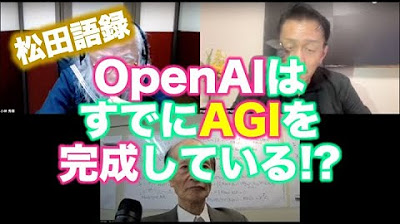OpenAI CEO Sam Altman and CTO Mira Murati on the Future of AI and ChatGPT | WSJ Tech Live 2023
Summary
TLDRこのビデオのスクリプトでは、人工知能(AI)と全般的人工知能(AGI)の将来に関する議論が繰り広げられています。登場人物はAIが人間の労働や創造性をどのように変えるか、そしてAGIが人間の状態を改善するためにどのように使用されるかについて話し合っています。安全性と信頼性の重要性、データの使用と経済的な影響、AIの倫理的な側面についても議論されています。AIが社会や仕事の性質に与える影響、およびこれらの技術がどのように安全に展開されるべきかについての考察が含まれています。
Takeaways
- 😀 人間性についての質問がされ、ユーモアや感情が人間らしさを象徴していると示された。
- 🤖 AIや機械知能の将来について懸念が表明されたが、人間とコンピュータは異なる点で優れているとの楽観的な見方も示された。
- 🎨 創造性はAIにとって予想よりも簡単であり、例えばDALL-EやGPT-4が創造的な作品を生み出している。
- 🚀 汎用AI(AGI)の目標とその人間の状況改善における重要性が説明され、豊富で安価な知能とエネルギーが重要であるとされた。
- 🧠 AGIの定義について言及され、多くのデジタルドメインにわたって一般化できるシステムとされた。
- 📈 AIの発展は継続的であり、社会や職場におけるAIの影響は次第に認識されている。
- 🔍 データの取り扱いとAIモデルの訓練についての倫理的な考慮が議論された。
- 🤝 AI技術の開発と展開における安全性と信頼性の確保が重要視されている。
- 🌐 社会とAI技術の関係性が変化しており、人々はAIとのインタラクションを通じて新しい関係を築いている。
- 🎓 職場の未来とAIによる仕事の変化についての懸念と希望が語られた。
Q & A
AIや機械知能が人間の仕事を置き換えることに対する懸念は何ですか?
-AIや機械知能がドライバーや医師などの仕事を置き換える可能性があることですが、最適な観点からは、コンピューターと人間は非常に異なる能力を持っており、互いに補完関係にあるという見方もあります。例えば、コンピューターは大量のデータを分析することに長けていますが、判断力や創造性、共感といった能力においては、現在のところ人間の方が優れています。
2023年時点でのAIに関する見通しはどのように変化しましたか?
-AIがまずロボットのような単純作業を得意とし、次に高度な判断を下す仕事に進むという予測から、創造性を含む分野でAIが予想外に進歩したことが明らかになりました。例えば、DALL-E 3やGPT-4などのモデルは、驚くべきイメージや創造的な物語を生成できます。
AGI(汎用人工知能)とは何ですか?
-AGIは、多岐にわたるドメインで人間と同等の作業を一般化できるシステムであり、生産性や経済的価値を大幅に生み出すことができます。
AGIを目指す理由は何ですか?
-AGIと豊富かつ安価なエネルギーは、人間の状況を最も改善する上で次の数十年で最も重要な2つの要素であり、AGIはこれまでに人類が作り出した最高のツールとなり得ると考えられています。
将来のAI技術の安全性と信頼性を確保するために重要な要素は何ですか?
-技術の能力を高めることと同時に、システムが信頼できるものであり、堅牢であることを保証することが重要です。これには、AIモデルのスケーリングと多様なモダリティへの対応が含まれます。
ChatGPTやその他のAIモデルは人間の友人や愛人になり得ますか?
-AIシステムは人間の日常生活の多くの側面において重要な役割を果たす可能性があり、非常にパーソナライズされた関係を築くことができますが、これには大きな責任が伴います。
人工知能(AI)の発展において、社会との関わりはどうあるべきですか?
-AIの開発と展開は、全社会的な議論が必要であり、多くの異なるアクターが参加するべきであるという考えがあります。
AI技術の安全な展開に向けた具体的な取り組みにはどのようなものがありますか?
-技術の開発だけでなく、実世界での応用を通じて社会が適応できるように段階的に能力を向上させ、実際に使用されることで生じる可能性のあるリスクを理解し、対策を講じることが重要です。
AI技術の将来に関する最大の恐れと希望は何ですか?
-最大の希望は、AI技術が人類にとって非常に有益なものとなり、多くの問題を解決し、創造的な表現の新たな方法をもたらすことです。一方で、非常に強力な技術であるため、その悪用や予期せぬ副作用に関する恐れもあります。
AIによる仕事の変化への対応として社会は何をすべきですか?
-技術の進歩による仕事の変化に対応するためには、教育や再訓練の機会を提供し、仕事の変化に伴う移行期間を支援するための政策や制度を開発することが重要です。
Outlines

This section is available to paid users only. Please upgrade to access this part.
Upgrade NowMindmap

This section is available to paid users only. Please upgrade to access this part.
Upgrade NowKeywords

This section is available to paid users only. Please upgrade to access this part.
Upgrade NowHighlights

This section is available to paid users only. Please upgrade to access this part.
Upgrade NowTranscripts

This section is available to paid users only. Please upgrade to access this part.
Upgrade Now5.0 / 5 (0 votes)






